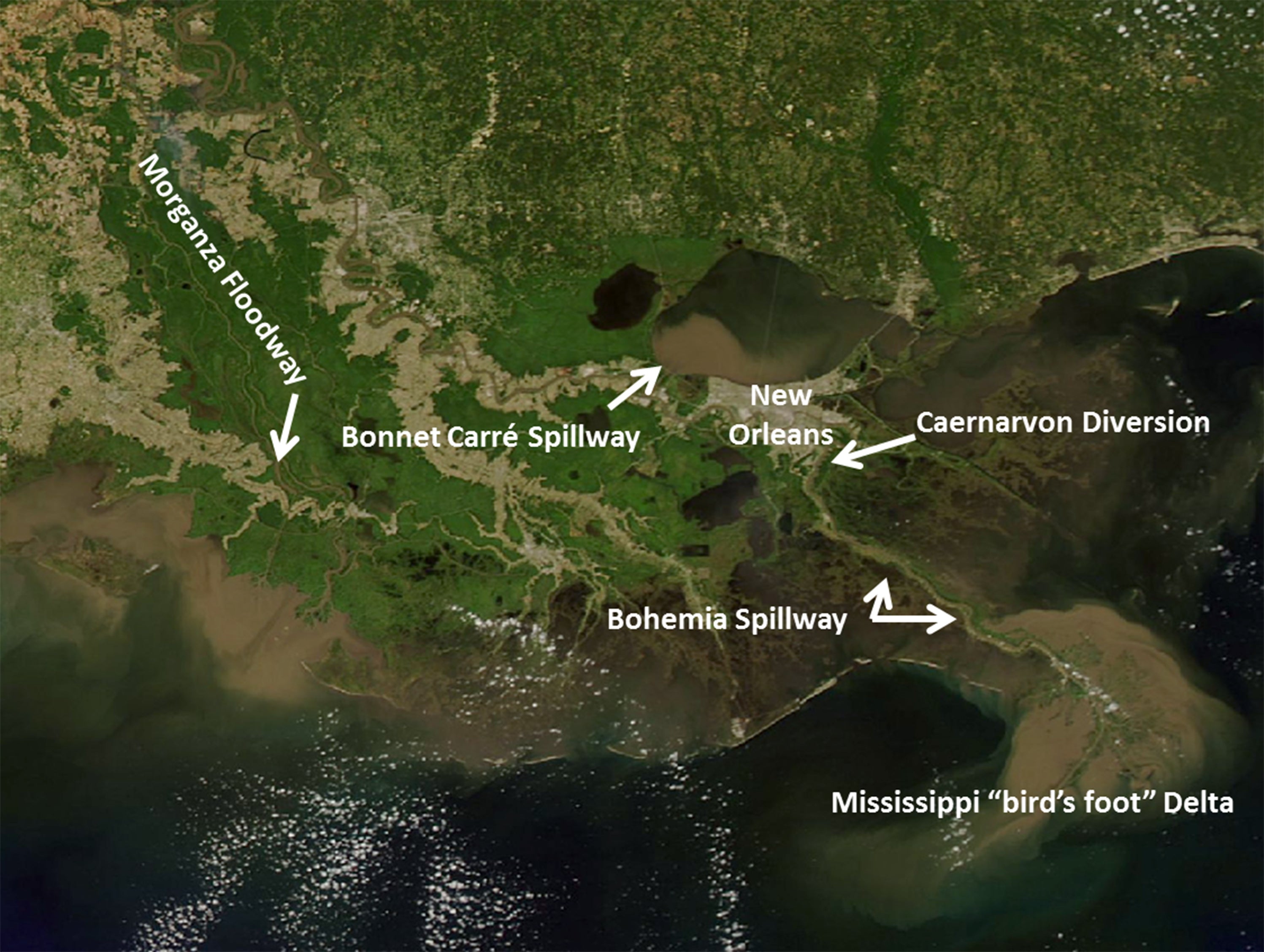What can the Caernarvon Diversion and Bohemia Spillway teach us about coastal restoration?
By Theryn Henkel, Ph.D., Lake Pontchartrain Basin Foundation
The Coastal Sustainability Program at the Lake Pontchartrain Basin Foundation (LPBF) recently released an article titled “Examination of Deltaic Processes of Mississippi River Outlets–Caernarvon Delta and Bohemia Spillway in Southeastern Louisiana” in the Gulf Coastal Association of Geological Societies Journal. The article details work that LPBF has done investigating the development of the Caernarvon Delta and operation of the Bohemia Spillway, both located in Plaquemines Parish, La.
Natural land-building deltaic processes of the Mississippi River Delta have been severely limited by artificial river levees, which prevent water and sediment from flowing over the banks during spring floods. To counteract the effects of severing the connection between the river and the delta, focus has been placed on reconnecting the river to the surrounding wetlands by the creation of artificial outlets, also called diversions.
The Caernarvon Freshwater Diversion was designed to deliver up to 8,000 cubic feet per second (cfs) of water from the Mississippi River. For reference, a flow rate of 8,000 cfs could fill up an Olympic-size swimming pool in 11 seconds or the Superdome in 4.5 hours. The Mississippi River also contains sediment that is carried along with the fresh water through the Caernarvon Diversion into the adjacent wetlands or open water, where it can nourish the wetlands and/or build land.

Record of Caernarvon Freshwater Diversion discharge and turbidity for 2012, as an example of the discrepancy between timing of diversion operations and sediment spikes entering the Caernarvon Receiving Basin.
LPBF collects data on the turbidity, or cloudiness, of the water diverted through the diversion. Through established equations, the cloudiness of the water can be related to sediment load or the amount of sediment carried in the water. From this, it was calculated that the total amount of sediment carried into the wetlands and open waters areas from 2009 to 2012 was 264,000 cubic yards, or a volume equal to 81 swimming pools. Due to other considerations, the diversion is not always operated when the sediment load in the river is high and therefore does not maximize potential sediment capture. Despite this variability in operation of the diversion – and the fact that the Caernarvon Diversion was built to minimize sediment capture, as it was built solely for salinity control, not land building – there actually has been enough sediment diverted by the Caernarvon Diversion to build a new delta. Total wetland growth of the delta in the open water area receiving diverted water from 1998 to 2011 was 600 acres. This new wetland area is lush and thriving with a variety of plant species (trees and herbaceous) growing, and alligators, birds and insects abound.
The Bohemia Spillway is an 11-mile stretch along the east side of Mississippi River south of New Orleans where the federal protection levees were removed. It was created in 1926 by the removal of existing artificial river levees, thereby allowing river water to flow over the banks and into the adjacent wetlands when the river was high. This overflowing process is how the river would have operated historically.

Location of the Caernarvon Diversion and Bohemia Spillway in relation to New Orleans and other river outlets.
In 2011, the Mississippi River watershed experienced an historic flood which provided an ideal opportunity to investigate and study how the spillway operates. When the river overflows its banks, if brings fresh water, nutrients and sediment to the wetlands. This cannot happen when the connection is cut off by levees. The severing of the connection of the river to the wetlands is one of the contributing factors to the high rates of land loss rates experienced by southeast Louisiana.
Current land loss rates in the Bohemia Spillway are negligible, perhaps due to receiving inputs of fresh water, nutrients and sediment during high river events since 1926. We have not observed delta formation in the Bohemia Spillway, as we did at the Caernarvon Diversion, but we have observed the infilling of defunct navigation and oil and gas canals as they slowly convert back to land.
In many parts of Louisiana’s coast, man-made canals often contribute to increased land loss. Poorly maintained canals erode and become wider, and salt water is conveyed through the canals into adjacent fresh marshes, killing plants and converting land to open water. Therefore, seeing canals infilling and low rates of land loss in the Bohemia Spillway indicates that the restoration of somewhat normal processes, by reconnecting the river to the wetlands since 1926, has had a positive effect on the area.
Looking Ahead
For both Bohemia Spillway and the Caernarvon Diversion, there are clearly benefits to sustaining or increasing wetland areas. However, the two outlets also provide a contrast in the future possibilities. Precisely replicating the Bohemia Spillway by levee removal is generally not feasible because of the ongoing need for protection from river floods. However, a controlled diversion built and operated to more efficiently capture and deliver sediment in ways that emulate more natural processes, such as in the Bohemia Spillway, may hold great promise for coastal restoration, rather than the obsolete design and operational goals of a diversion such as Caernarvon.